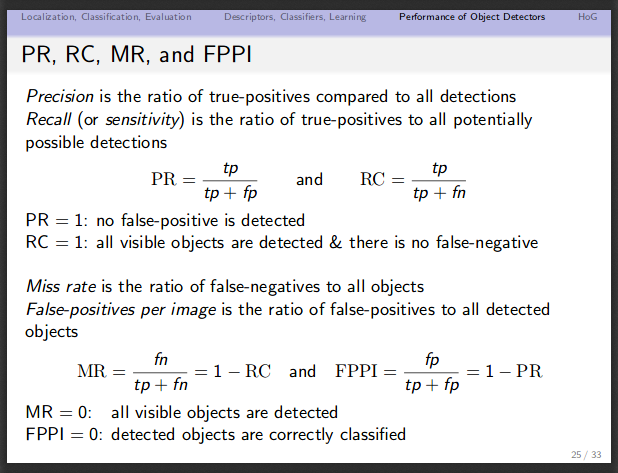-
Notifications
You must be signed in to change notification settings - Fork 909
New issue
Have a question about this project? Sign up for a free GitHub account to open an issue and contact its maintainers and the community.
By clicking “Sign up for GitHub”, you agree to our terms of service and privacy statement. We’ll occasionally send you account related emails.
Already on GitHub? Sign in to your account
Is there any way to calculate log-average miss rate? #43
Comments
|
Hello, |
|
Thanks, @Cartucho. I have another issue |
|
Hum, that's strange indeed. Although, I am not really aware of how In this repo, I use the most recent version of the official PASCAL VOC code. |
|
Great work! Waiting for the log-average miss rate update. @Cartucho |
|
Ok, I will start it now |
|
@nguyendu392 @ZHANGHeng19931123 do you have any legit documentation explaining how to calculate the log-average miss rate? |
|
References:
|
|
@ZHANGHeng19931123 @nguyendu392 Done! You will now find a plot in the |
Great work! Thanks a lot! While I might have spotted two small bugs: Line 651: you calculate your lamr after map, but in your function 'voc_ap', you've changed the variable 'rec' and 'prec' by insert values at the beginning and end of your two lists. Line 88: miss rate is 1-recall instead of 1-precision. ref: FNR=1-TPR. And I have a small question please: I've checked the version Matlab (https://github.com/pdollar/toolbox/blob/master/detector/acfTest.m), and you have done the same things by calculating mr with miss=exp(mean(log(max(1e-10,1-miss)))). But in the paper, It is "averaging miss rate at nine FPPI rates evenly spaced in log-space". Why not use the average? Waiting for your answer :) |
|
Hello, you are right! I have fixed them both!
Because it is an average in log-space: the log-average formulation of the geometric mean.. |
Thank you for your reply! Have you ever checked if your result is identical with the MATLAB function 'evaluateDetectionMissRate'? I've quickly built two small scripts for the format convert and Matlab evaluation. I don't have Matlab installed, could you verify if they gave the same result? 'convert_for_matlab.py' to convert .txt files in 'ground-truth' and 'predicted' to .mat. May exits bugs, cause I can't debug without Matlab.. |
|
@ZHANGHeng19931123 sure, thank you for those scripts, I will check it out! I can only work on this next week because this one I'm very busy! |
|
have anybody plot MR-FPPI curse succeedly? I use plt.plot(fppi, mr,), but the result is wrong,whether I use wrong code?looking forward for your answer |
|
@Cartucho |
|
For information, I finally switch to Matlab for MR calculation, even though I didn't find any error in @Cartucho 's Python script... |
|
@ZHANGHeng19931123 |
yeah, they are different, but I didn't find what is wrong with his code @Joker316701882 |
|
I think I found the mistake, please let me know. Found this source here: looks like we shouldn't be using fp_cumsum, but using fppi = 1 - precision? also, here's another reference - https://eavise.gitlab.io/brambox/_modules/brambox/stat/_mr_fppi.html#mr_fppi |
|
@SreenivasVRao thank you for sharing this. @Joker316701882 if you still have the code do you think you could give it a try? |
|
@Cartucho @ZHANGHeng19931123 @Joker316701882 @SreenivasVRao not In bboxOverlapRatio.m, it said After fixing this error, the larm calculated by python and matlab are same(in my own data). |
|
Hi @Cartucho if possible how to generate confusion matrix for two or more classes? |


Hello,
I want to evaluate my prediction on mine dataset with YOLOv3 which is using the log-average miss rate metric?
Could you guide me how to do it?
Thanks.
The text was updated successfully, but these errors were encountered: